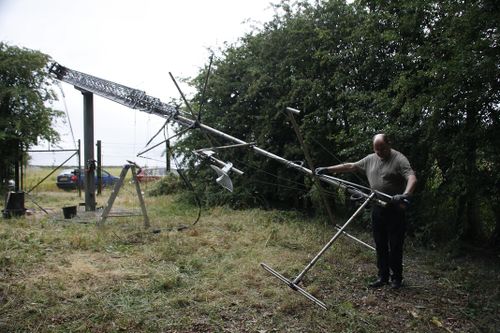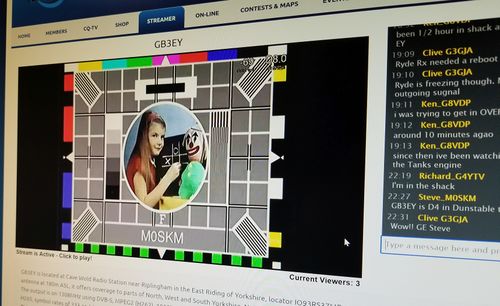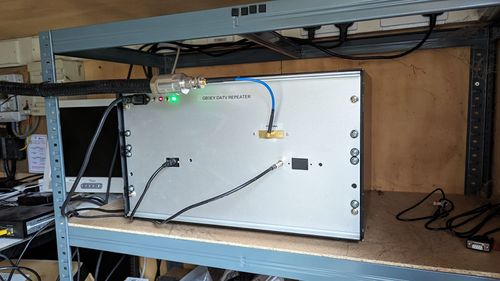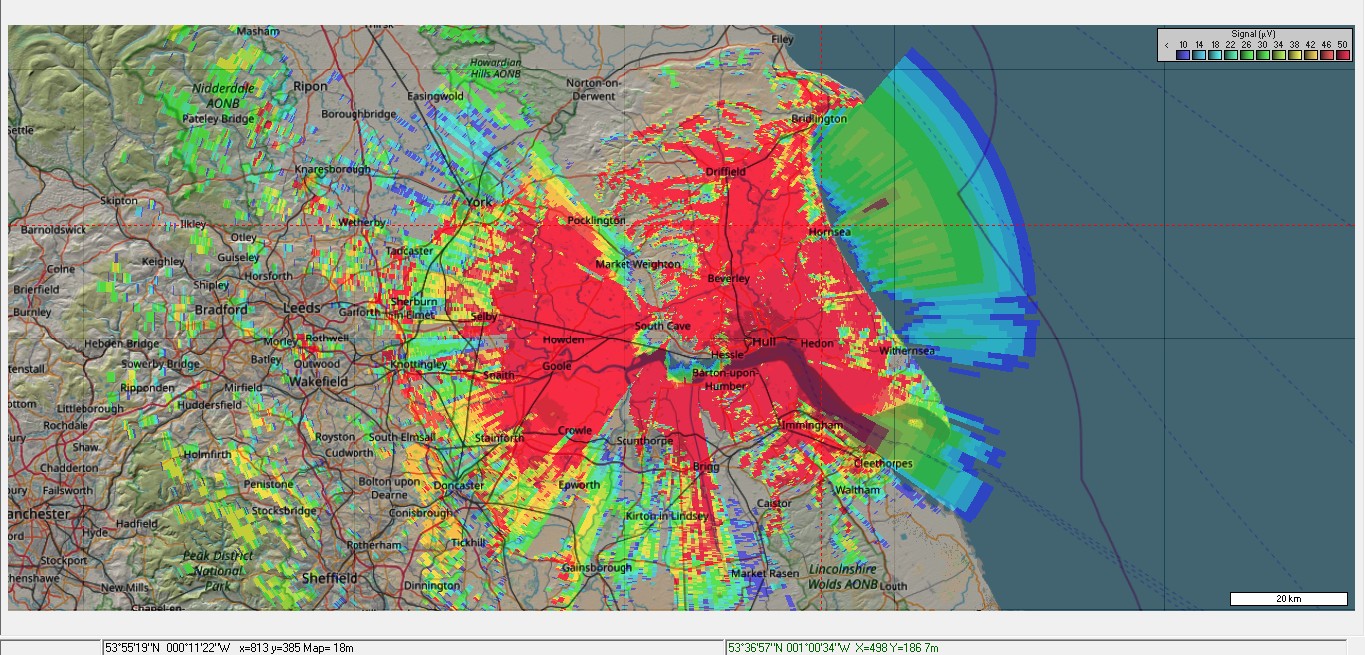Difference between revisions of "GB3EY - Near Hull IO93RS"
| (10 intermediate revisions by the same user not shown) | |||
| Line 1: | Line 1: | ||
| − | ''' | + | '''Now fully digital. Please send reports of reception to clive @ hesh.co.uk''' |
| − | '''Output: 1308MHz, DVB- | + | '''Output: 1308MHz, DVB-S2, QPSK, 1000kS/s, H.264, FEC 3/4, stereo audio.''' |
| − | '''Input: 1275MHz, DVB-S QPSK or DVB-S2 QPSK or DVB-S2 8PSK, 333 or | + | '''Input: 1275MHz, DVB-S QPSK or DVB-S2 QPSK or DVB-S2 8PSK, 250, 333, or 500kS/s, H262, H264 or H265, any valid FEC''' |
| − | ''' | + | '''The QTH locator is IO93RS37ME''' |
| − | + | '''When idle, the repeater relays the ATV calling channel (144.750MHz CTCSS 88.5Hz) on its sound channel | |
| − | + | ||
| + | '''Note that GB3EY is switched off between 11pm and 2pm every day to save electricity.''' | ||
| + | <br><br> | ||
| + | [[File:GB3EY Coverage.jpg|frame|center|GB3EY Coverage]] | ||
| + | The site is 155m ASL and the Alford Slot antenna is at 180m ASL with a good take off in most directions. The predicted coverage was created using Radiomobile and assumes 10m mast with a 15dBi antenna at the receiving end<br> | ||
<br> | <br> | ||
| − | The repeater | + | The repeater transmits 1000kS/s, FEC 3/4, with H.264 encoding on 1308MHz from a single Alford Slot antenna that was installed at 25m AGL fed with 33m of Andrews LDF5-50A. The Alford was made by G3GJA and uses a coaxial 4:1 balun formed from RG402 semi-rigid. This was found to be much easier to construct and test than the usual slotted sides coax balun approach. A work party at the EYRG site checking the P80 tower with 5m extension. A further 3m extension has been added for the Alford Slot<br><br> |
| − | + | The transmitter, comprising of a ALDALM Pluto SDR and two modules funded by G4YTV, were made by Bert PE1RKI. They provide 11 watts of RF power at the output the duplexer. The duplex filter, a two pole transmit leg inter-digital filter and a five pole inter-digital receive filter were sourced from ID Electronik Gmbh in Germany. The filters allow GB3EY to use a single antenna without any desense and at the same time apply in excess of 100dB of attenuation to the Claxby Radar on 1254.5MHz just 20.5MHz from the input frequency. The radar runs 400MW EIRP and is only 25 miles from the repeater and puts -10dBm into the repeater.<br><br> | |
| − | A work party at the EYRG site checking the P80 tower with 5m extension. A further 3m extension has been added for the Alford Slot<br><br> | + | [[File:tower.jpg|500px]]<br> |
| − | |||
| − | |||
| − | + | The BATC Repeater Controller software running on a Raspberry Pi replaced the logic from the FM analogue repeater in January 2024 when the repeater was converted from digital>analogue>digital to digital signal paths only. It takes incoming video from a BATC Ryde receiver and Khune 132A2 pre-amp via seamless quad HDMI switches that select the source to be relayed. It is then passed to a LinkPi ENC v2 encoder that produces two H.264 IP streams; one at HD resolution is sent to the BATC Streamer and the other at full HD resolution is sent via Ethernet to the SDR. The BATC Streamer feed can be seen here: http://batc.org.uk/live/gb3ey. The Internet is linked to the repeater site by a 6cm link over a 10km path that gives up to 80Mbps downstream / upstream. | |
| + | <br><br> | ||
| + | [[File:M0SKM.jpg|500px]],<br> | ||
| + | M0SKM nr Dunstable as seen through GB3EY at 209km | ||
| + | <br><br> | ||
| − | The | + | The repeater links parts of Yorkshire with ATV that can't be worked direct on 2m, so extensive use is made of GB3NY on 430.8375MHz (CTCSS tone A, 67Hz) for talkback. GB3NY is located 2.8km north of GB3EY and has a similar coverage area.<br> |
| + | The repeater also has a 144.750MHz audio input (CTCSS 88.5Hz) that is active when the repeater is idle and showing slides.<br><br> | ||
| − | + | The site is exclusively used by the East Yorkshire Repeater Group and is a former Pye Telecoms location. It also hosts GB3HS a 2m dual mode repeater, GB7HU a 70cm D-Star repeater, an ADS-B receiver feeding ADS-B Exchange and a Netmore LoRaWAN unit.<br><br> | |
| − | |||
| − | + | [[File:GB3EY installation.jpg|500px]] <br>GB3EY on 24/01/2024<br> | |
| − | + | <br> | |
| − | + | A new NoV was issued for GB3EY in August 2018 allowing the move to the East Yorkshire Repeater Group's site at Cave Wold Radio Station near South Cave in East Yorkshire. Test transmissions were run from a temporary mast and transmitter from August to October 2019 until the main tower was renovated and extended. EY relayed its first digital pictures on the 22nd November 2020 and all digital operation commenced on the 24 January 2024. The move has proved to be a vast improvement over the old site on the North Sea coast at Aldbrough. | |
| − | |||
| − | |||
| − | |||
| − | |||
| − | |||
| − | |||
| − | |||
| − | |||
| − | |||
| − | |||
| − | |||
| − | |||
| − | |||
| − | |||
| − | |||
| − | |||
| − | |||
| − | |||
| − | |||
| − | |||
| − | + | We hope to resurrect GB3XY the 10GHz ATV repeater, that was operational from the same site, as a DATV repeater linked to GB3EY. An antenna, duplexer, power amplifier, 3cm transverter kit and an encoder have been acquired for the project. It's hoped to repair EY's old Ryde to use as a receiver for XY. | |
| − | |||
Latest revision as of 21:57, 22 February 2024
Now fully digital. Please send reports of reception to clive @ hesh.co.uk
Output: 1308MHz, DVB-S2, QPSK, 1000kS/s, H.264, FEC 3/4, stereo audio.
Input: 1275MHz, DVB-S QPSK or DVB-S2 QPSK or DVB-S2 8PSK, 250, 333, or 500kS/s, H262, H264 or H265, any valid FEC
The QTH locator is IO93RS37ME
When idle, the repeater relays the ATV calling channel (144.750MHz CTCSS 88.5Hz) on its sound channel
Note that GB3EY is switched off between 11pm and 2pm every day to save electricity.
The site is 155m ASL and the Alford Slot antenna is at 180m ASL with a good take off in most directions. The predicted coverage was created using Radiomobile and assumes 10m mast with a 15dBi antenna at the receiving end
The repeater transmits 1000kS/s, FEC 3/4, with H.264 encoding on 1308MHz from a single Alford Slot antenna that was installed at 25m AGL fed with 33m of Andrews LDF5-50A. The Alford was made by G3GJA and uses a coaxial 4:1 balun formed from RG402 semi-rigid. This was found to be much easier to construct and test than the usual slotted sides coax balun approach. A work party at the EYRG site checking the P80 tower with 5m extension. A further 3m extension has been added for the Alford Slot
The transmitter, comprising of a ALDALM Pluto SDR and two modules funded by G4YTV, were made by Bert PE1RKI. They provide 11 watts of RF power at the output the duplexer. The duplex filter, a two pole transmit leg inter-digital filter and a five pole inter-digital receive filter were sourced from ID Electronik Gmbh in Germany. The filters allow GB3EY to use a single antenna without any desense and at the same time apply in excess of 100dB of attenuation to the Claxby Radar on 1254.5MHz just 20.5MHz from the input frequency. The radar runs 400MW EIRP and is only 25 miles from the repeater and puts -10dBm into the repeater.

The BATC Repeater Controller software running on a Raspberry Pi replaced the logic from the FM analogue repeater in January 2024 when the repeater was converted from digital>analogue>digital to digital signal paths only. It takes incoming video from a BATC Ryde receiver and Khune 132A2 pre-amp via seamless quad HDMI switches that select the source to be relayed. It is then passed to a LinkPi ENC v2 encoder that produces two H.264 IP streams; one at HD resolution is sent to the BATC Streamer and the other at full HD resolution is sent via Ethernet to the SDR. The BATC Streamer feed can be seen here: http://batc.org.uk/live/gb3ey. The Internet is linked to the repeater site by a 6cm link over a 10km path that gives up to 80Mbps downstream / upstream.
 ,
,
M0SKM nr Dunstable as seen through GB3EY at 209km
The repeater links parts of Yorkshire with ATV that can't be worked direct on 2m, so extensive use is made of GB3NY on 430.8375MHz (CTCSS tone A, 67Hz) for talkback. GB3NY is located 2.8km north of GB3EY and has a similar coverage area.
The repeater also has a 144.750MHz audio input (CTCSS 88.5Hz) that is active when the repeater is idle and showing slides.
The site is exclusively used by the East Yorkshire Repeater Group and is a former Pye Telecoms location. It also hosts GB3HS a 2m dual mode repeater, GB7HU a 70cm D-Star repeater, an ADS-B receiver feeding ADS-B Exchange and a Netmore LoRaWAN unit.

GB3EY on 24/01/2024
A new NoV was issued for GB3EY in August 2018 allowing the move to the East Yorkshire Repeater Group's site at Cave Wold Radio Station near South Cave in East Yorkshire. Test transmissions were run from a temporary mast and transmitter from August to October 2019 until the main tower was renovated and extended. EY relayed its first digital pictures on the 22nd November 2020 and all digital operation commenced on the 24 January 2024. The move has proved to be a vast improvement over the old site on the North Sea coast at Aldbrough.
We hope to resurrect GB3XY the 10GHz ATV repeater, that was operational from the same site, as a DATV repeater linked to GB3EY. An antenna, duplexer, power amplifier, 3cm transverter kit and an encoder have been acquired for the project. It's hoped to repair EY's old Ryde to use as a receiver for XY.
